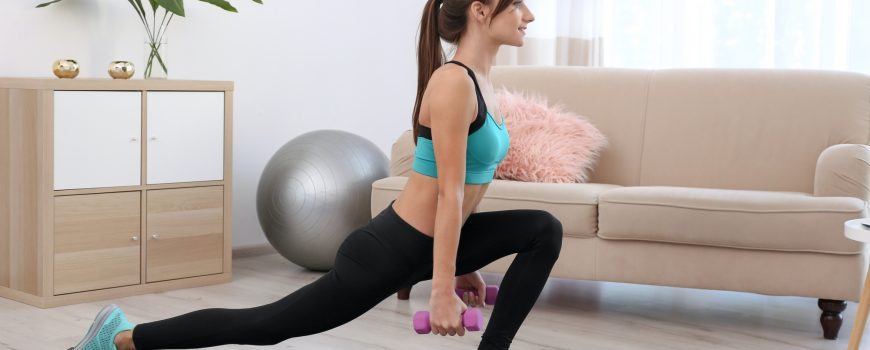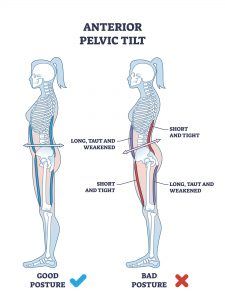
How To Fix Anterior Pelvic Tilt Posture

Anterior pelvic tilt posture is when the hips tilt forward, causing the lower back to over-arch and can make the buttocks more prominent. It might look like you’re trying to strut your stuff, but you’re putting unnecessary strain on your muscles and joints.
Anterior pelvic tilt can lead to several problems, including lower back pain, hip pain, poor posture, reduced flexibility, muscle imbalances, and increased risk of injury during physical activity. Additionally, it can affect the alignment of the spine and pelvis, forcing certain muscles to compensate and leading to further issues. By understanding and addressing this posture, you can move towards a more comfortable and confident stride.
So, how can you fix your anterior pelvic tilt and improve your posture? Let’s find out!
5 Ways To Fix Anterior Pelvic Tilt Posture
You can fix anterior pelvic tilt with proper exercise and stretching techniques. By stretching and strengthening the muscles that surround the pelvis, you can improve your posture and reduce pain associated with anterior pelvic tilt.
However, it’s important to note that serious cases may require professional care, and it’s always best to consult with a healthcare provider before starting any new exercise program.
1. Stretch Your Hip Flexors
Tight hip flexor muscles are associated with anterior pelvic tilt; Thus, stretching the hip flexors regularly can help alleviate this posture. Examples of some common hip flexor stretches include lunges, the kneeling hip flexor stretch, and pigeon poses in yoga.
2. Strengthen Your Glutes and Core
Weak glutes and core muscles can exacerbate anterior pelvic tilt. Strengthening these muscles can help improve support proper alignment and prevent future pain or injury. Consider adding some of these exercises to your routine:
- Bodyweight Squats
 Squats can help correct anterior pelvic tilt by strengthening the glutes, hamstrings, and quads. Focus on maintaining proper form, keeping the knees aligned with the toes, and not letting them cave inwards. Squeezing the glutes at the top of the movement can help activate them further. You can also add weight to your squats to get more out of the exercise! Don’t forget to engage your core throughout the movement to adequately support your pelvis and spine.
Squats can help correct anterior pelvic tilt by strengthening the glutes, hamstrings, and quads. Focus on maintaining proper form, keeping the knees aligned with the toes, and not letting them cave inwards. Squeezing the glutes at the top of the movement can help activate them further. You can also add weight to your squats to get more out of the exercise! Don’t forget to engage your core throughout the movement to adequately support your pelvis and spine.
- Glute Bridge
The glute bridge works by engaging the glutes and can help improve hip extension, which can correct anterior pelvic tilt. Lie on your back with your knees bent and your feet flat on the floor. Then, lift your hips off the ground. Hold for a few seconds and lower back down.
- Plank
The plank is a great exercise for strengthening core muscles, which can help improve overall posture. Start in a push-up position (knees up or on the ground) with your forearms on the ground, and hold for 30-60 seconds or until you can’t hold it any longer.
- Deadlift
The deadlift is a compound exercise that strengthens the glutes, hamstrings, and lower back, which are all important for correcting anterior pelvic tilt. Start with light weights and maintain proper form throughout the movement to avoid injury.
3. Use Correct Posture and Support
 Sitting for prolonged periods with poor posture, as many of us do at our office jobs, can contribute to anterior pelvic tilt. Ensuring you have a straight back while sitting and taking regular breaks to move and stretch can prevent this undesirable pelvic posture and potential adverse effects. When sitting, you should try and make sure that your feet are flat on the floor, your hips are level, and your back is straight.
Sitting for prolonged periods with poor posture, as many of us do at our office jobs, can contribute to anterior pelvic tilt. Ensuring you have a straight back while sitting and taking regular breaks to move and stretch can prevent this undesirable pelvic posture and potential adverse effects. When sitting, you should try and make sure that your feet are flat on the floor, your hips are level, and your back is straight.
TIP: Using a lumbar support cushion while sitting and a pillow between the knees while sleeping can help maintain proper alignment of the spine and pelvis!
4. Seek Out Professional Help
In some cases, anterior pelvic tilt may require professional intervention from a chiropractor or physiotherapist to address underlying muscle imbalances or alignment issues. A chiropractor can help ensure your spine is properly aligned, which may support good pelvic alignment too!
Our team at Chatfield Chiropractic in Roxburgh Park and Sunbury are ready to help you with any postural deficits. Contact us today to book your appointment!
